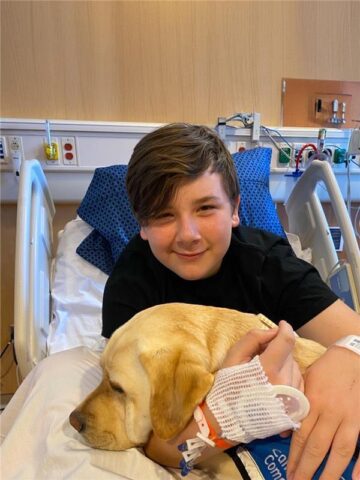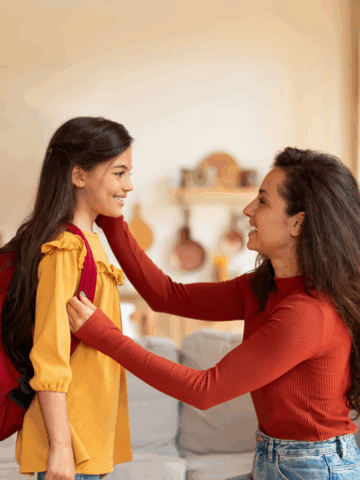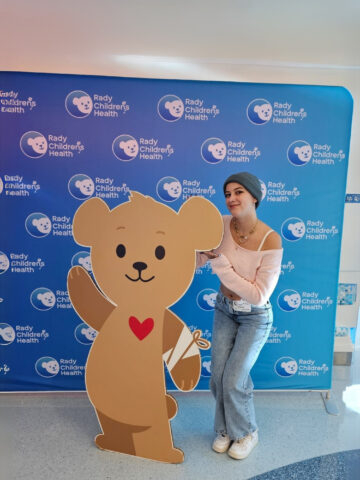Written by Daniel Boucher, cancer survivor and current CHOC volunteer
My name is Daniel, and ever since I can remember, I have always wanted to play football for the University of Notre Dame. I had many motivations: my dad went there, they put academics before football, and I consider it almost a holy place, where people “surrender to excellence” in their personal life, academics and community. And I had an athletic build too. At 10 years old, I was already 5 feet 2 inches and well on my way to achieving, if not surpassing, my dad’s height of 6 feet 3 inches. I had a competitive, determined drive in any situation. I was only satisfied if I gave my all.
I was ten years old when everything changed. It was a November afternoon and I was doing what I loved most― playing football. Trying to tackle my little brother, I followed the advice so often quoted in sports: keep your eye on the ball. As a consequence, I ran into a tree face first. I came home and threw up once or twice, but otherwise seemed unharmed. I didn’t really lose consciousness, but my dad took me to the emergency room just to be safe. That visit changed my life. It was a slow day, and there was an available CAT scan machine. Figuring that it would be no harm, the doctor ordered a scan. That scan revealed a cancerous mass sitting on the edge of my spinal cord.
Within hours, I was diagnosed with medulloblastoma, a type of cancer that often spreads to other parts of the brain and spinal cord. I met my pediatric neurosurgeon, Dr. William Loudon, and was scheduled for brain surgery. I remember watching “Honey I Shrunk the Kids” before surgery and telling my younger brother (whether out of innocence or the sheer confidence and determination I applied to every situation) that I’d be home in a week. If my parents heard me say this, they never tried to tell me otherwise. My dad later confided in me that this was one time where he truly thought I wasn’t going to make it. I didn’t fulfill my promise to my brother- after surgery the doctors kept me unconscious for two days, giving my brain the best chance to recover from the surgery, and stayed in the hospital for two weeks before I got to go home. It felt so good to be in my own bed again that I slept for 21 hours straight.
My immune system was weak, and when I came down with a fever I had to go back to the hospital. Unfortunately, it turned out to be a symptom of pressure buildup in my spine. I remember that the hospital was getting in the Christmas spirit at that time. There was holiday music playing and I even got to attend a party while I was admitted, but I got to go home in time for Christmas. After the holidays, I started on my cancer’s treatment regimen under the careful eye of my oncologist, Dr. Lilibeth Torno.
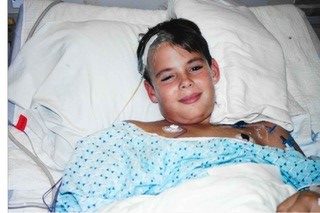
For the entire month of January, Monday through Friday, I would go to the CHOC Outpatient Infusion Center (OPI) cancer center from 8 a.m. – 12 p.m. There, I received chemotherapy treatments delivered intravenously through my portacath, which connected to an artery on my chest and made access to a blood vessel less painful and more practical than a needle in my arm. I usually slept for the first hour of my infusion. Later in the session, my mom would feed me ramen and read me “The BFG” by Ronal Dahl. Eventually my appetite increased so that I went back to eating my favorite food of corn dogs, and socializing to the point of befriending many of the nurses and asking if they had any ketchup. You can’t eat a corndog without ketchup. The nurses were so kind and hated to see me uncomfortable and they would bend over backward to help. A tall nurse named Ron took especially great care of me, and once I had asked for it, would bring me ketchup every day.
After chemotherapy, my mom and I would walk the CHOC hallways to the radiology department. My radiation treatment was twofold, one dose to the tumor site and one dose to the general brain. When I laid on the table to receive radiation, a special mask molded to my face and tattooed pinpoints on my back helped me line up in the exact right spot. Technicians would line me up and then I would lie for what seemed like hours (it was never that long) until they returned to help me up and send me home.
After I completed this first part of my strict but successful treatment plan, I came into the hospital for one weekend every three weeks. John was my favorite nurse and used to play practical jokes on me to cheer me up. I had a tricky vein but he could always get my IV inserted without hurting me. My dad came with me on these trips, and if I was feeling well enough, I got to visit the play room and receive visitors. My siblings would often come and we loved to play on the X-men arcade console. The machine had been modified to work without quarters, and we fully exploited this.
That June, I finished my last chemo treatment. It was a momentous occasion and my family hosted a party to celebrate. There was a bounce house, a slip and slide, and all my favorite foods. We even made a giant finish line banner across our driveway and t-shirts for the family. My favorite part, however, was visiting with my friends and family who had so generously helped with the behind-the-scenes work. Those who watched my younger siblings while mom was with me in the hospital, who made dinners, and especially who prayed unceasingly for my recovery and for my family.
Was I the same person who had hit that tree almost a year prior? No. Did I still have that physical strength to rush up and down a football field tackling other players? No. But the same attributes I’d always had within me in sports had been used to help me through my struggles. I had developed a different kind of toughness, one that is much more important. I may not have been able to run and throw a football down the field, but with my strong active spirit, I would look for new, less physical, adventures.
Recently I was invited to speak at a fundraiser to benefit pediatric neurosurgery at CHOC, so that Dr. Loudon and his colleagues can continue helping more kids the way they helped me when I was a patient. The event was a success, but the best part was getting to hang out with Dr. Loudon.
These days, I’m back at CHOC― this time as a hospital volunteer. I get to entertain kids in the same waiting rooms I used to visit as a patient. I read books, play games, do puppet show, and just be their buddy when they need entertainment or a distraction. I also get to host Turtle Talk, an interactive show in the Disneyland Resort lobby of the Bill Holmes Tower, where patients and siblings can interact and have live conversations with Crush, the animated sea turtle from “Finding Nemo.” Sometimes I even run into Dr. Loudon and Dr. Torno. I really appreciated the efforts of CHOC to make me motivated and happy, (not to mention the medical care to recover from my disease), and am now proud to help make your stay as good as mine.
Get more expert health advice delivered to your inbox monthly by subscribing to the KidsHealth newsletter here.
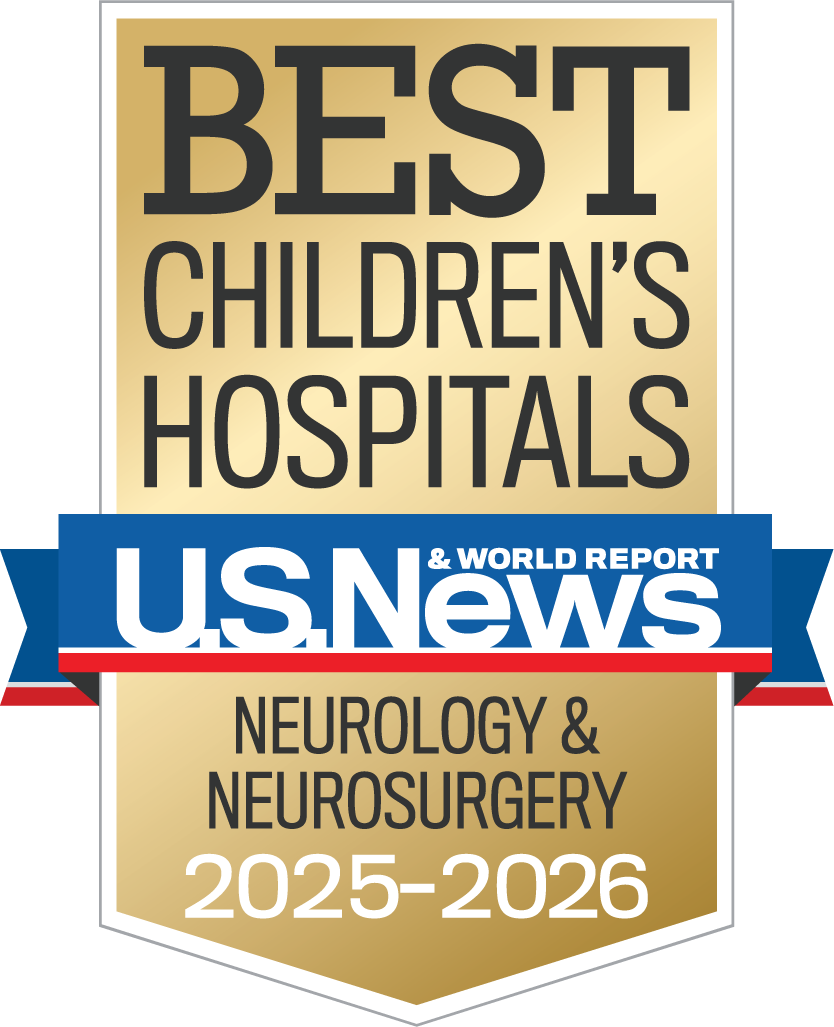
Learn more about CHOC’s Neuroscience Institute
CHOC Hospital was named one of the nation’s best children’s hospitals by U.S. News & World Report in its 2025-26 Best Children’s Hospitals rankings and ranked in the neurology and neuroscience specialties.

